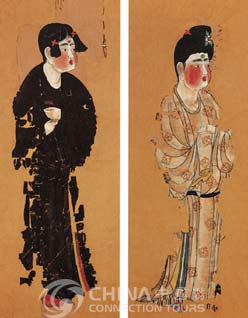 The Xinjiang Uighur Autonomous Region Museum was established in the spring of 1953 in the People's Park in Urumqi City. A new museum was later built in 1962 at a new site on Xibei Road. The building occupies a space of 11,000 square meters and is built in a modern style enhanced by local architectural features. The central dome is thirty meters high and from its height one can view the entire city of Urumqi.
The Xinjiang Uighur Autonomous Region Museum was established in the spring of 1953 in the People's Park in Urumqi City. A new museum was later built in 1962 at a new site on Xibei Road. The building occupies a space of 11,000 square meters and is built in a modern style enhanced by local architectural features. The central dome is thirty meters high and from its height one can view the entire city of Urumqi.
The Silk Road derived its fame from silk. The Xinjiang Uighur Autonomous Region Museum has also become famous for its rich collections of silk artifacts from many periods of history. Brocades from Eastern Han are highlighted, as well as all kinds of specialized silk-woven items from the height of the Tang. These are regarded as unique treasures by textile authorities and art historians around the world.
The Xinjiang Autonomous Region has long been a crossroads for people from different nationalities. Their diversity of scripts and cultures is exhibited in this museum through archaeological material, including documents in some twelve different scripts with a particularly large number from the Han-dynasty finds at Turpan. The documents cover military, economic, cultural, and political affairs. Clay or terracotta sculptures are also featured in the Xinjiang Museum.
 The Xinjiang Museum has several dozen original Tang-dynasty paintings. Although these are not from the hands of famous painters, they still exhibit the vital Tang spirit.
The Xinjiang Museum has several dozen original Tang-dynasty paintings. Although these are not from the hands of famous painters, they still exhibit the vital Tang spirit.
Other items in the collections include microfiches, silver works of art, stone steles, coins and currency, ceramics, wooden articles. Of particular note are various foods from the Tang dynasty which, through the arid conditions, have been preserved over the passage of more than one thousand years.
In a similar vein, certain desiccated human corpses, called mummies although they were not treated with chemicals, are kept in the Xinjiang Museum. Some of these date back to 4,000 years ago. They are the earliest known such examples in China and are important in the study not only of humankind but of ethnic composition in this region at the time. Also in the museum are an Eastern Han couple, buried together and well preserved, and a corpse from the Tang dynasty with well preserved skin and hair.
Presently, the museum opened new exhibits called the Xinjiang History Exhibition and the Xinjiang People's Customs Exhibition. The history exhibit shows the history of Xinjiang by using material from its rich collections and highlighting material from recent archaeological discoveries. The Customs exhibition introduces the customs and cultural lifestyles of twelve different ethnic groups in Xinjiang, including the Uighur, Kazakh, Mongolian, Kirgiz, Hui, Tajik, Uzbek, Russian, Tatar, Daur, Xibo, and Manchu.

